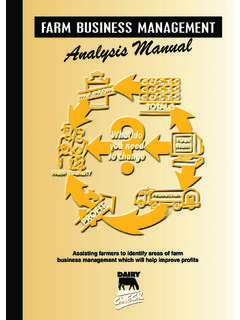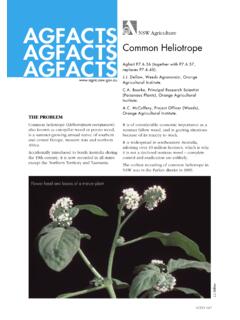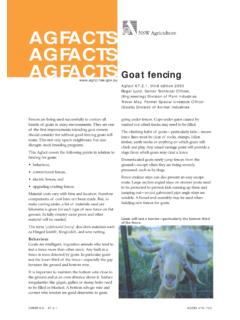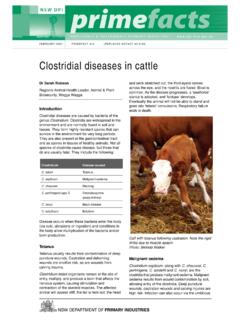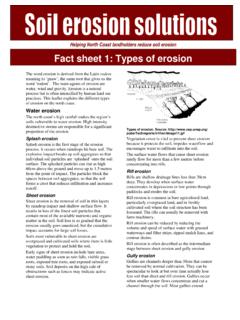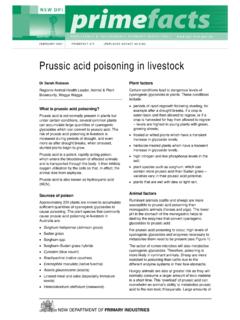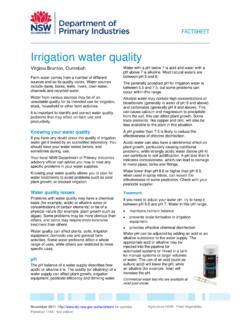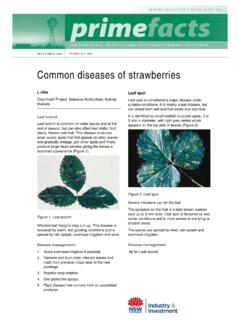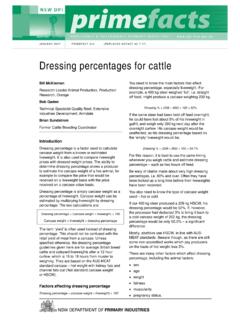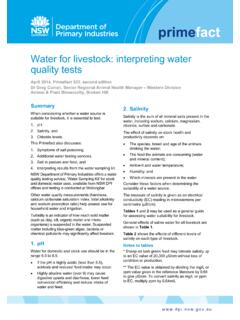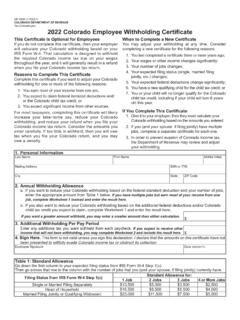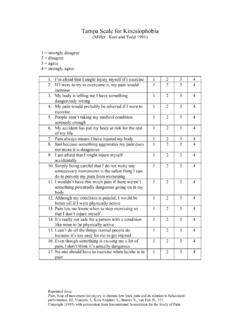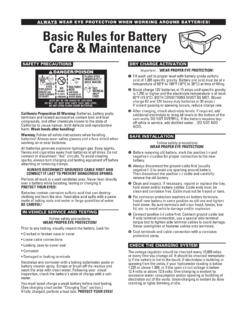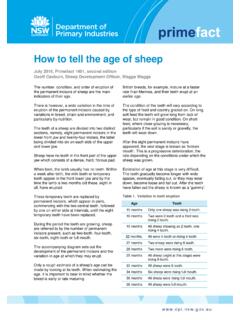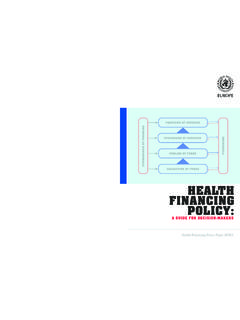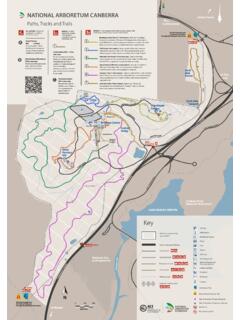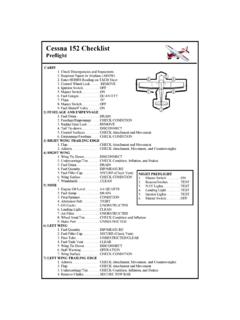Transcription of Fertiliser Calculations - Department of Primary Industries
1 1 Fertiliser CalculationsCarol Rose, Extension Agronomist, NSW Department of Primary IndustriesKempsey DPI 496 August, 2004 The following simple Calculations will allow you to accurately determine how much Fertiliser to put on your applying fertilisers of any type, you should assess the nutrient content of your soil, and understand that other factors - soil type, soil depth, current pasture or crop type and previous paddock history - need to be considered as a recommendation talks about units of a nutrient (eg phosphorus). A unit is the same as kilograms of that nutrient (eg 1 unit P is 1 kg P). But this is not the same as a kilogram of a :P:K:SFertilisers contain different amounts of nutrients, affecting the amount of the Fertiliser you need. The nutrients are often written on the bag or packing slip as percentages, or as N:P:K:S (nitrogen:phosphorus:potassium:sulfur). Example: Single superphosphate is 0 :0:11.
2 This means that in 100 kg, there is kg phosphorus, 11 kg sulfur. There is no nitrogen or 15 is 14 :0:11. This means that in 100 kg, there is 14 kg nitrogen, kg P, 11 kg sulfur and no the amount of Fertiliser required This information can be used to calculate the amount of a Fertiliser needed for a given amount of a nutrient: calculation AAmount of Fertiliser kg/ha = kg/ha nutrient % nutrient in Fertiliser x : You need 20 units (kg) /ha of phosphorus (P) and you plan to use single superphosphate with calculation AAmount of superphosphate required (kg/ha) = 20 kg/ha P P x 100 = 227 kg/haCalculating the amount of nutrient appliedYou can reverse this calculation to work out how much of a nutrient you are BAmount of nutrient (kg/ha) = Amount of Fertiliser (kg/ha) x % nutrient in Fertiliser 100 Example: You plan to apply 125kg/ha of single superphosphate (approx 1 bag/acre).
3 Apply calculation BAmount of P applied (kg/ha) = 125kg/ha x P 100 = 11 kg/ha PCalculating the cost per single nutrientYou should select fertilisers for the nutrients they supply, what your soils lack and what your plants require. If only one nutrient is deficient, compare fertilisers on the cost of that nutrient. Use the following calculation to compare the price of that CPrice per kg nutrient = Price per tonne 10 % nutrient Example 1: Paddock has high phosphorus (P) and low sulfur (S) so need to apply calculation CSingle superphosphate @ $262/t 10 11% S = $ per kg sulfur Gypsum @ $56/t 10 = $ per kg sulfur SF45 @ $335/t spread 10 42% S = $ per kg sulfur (but only of sulfur is in a readily available form, the rest is released by soil micro-organisms over several years)Note: Spreading cost can be added to price to compare fertilisers with different spreading costs.
4 Example 2: Paddock has high nutrients except nitrogen (N).Apply calculation CUrea @ $410/t 10 46% N = $ @ $580/t 10 18% N = $ Questions to ConsiderChoosing the Fertiliser to use should not just depend on price. You should also consider: Response to Fertiliser : Do you need Fertiliser ? For example, clover fixes its own nitrogen so does not need N application; native pastures are adapted to low phosphorus and may not respond to Fertiliser application. Availability: Is the Fertiliser you are considering available in your area, or at the time of year you want? Factor in freight costs. Availability of nutrient: Consider if the nutrients in the Fertiliser are slow-release or rapidly available. Handling: Can your machinery apply the necessary rates? Can you handle small bags or 1 tonne bags? Blends, while often more expensive, can be easier to handle.
5 If hiring someone to spread the Fertiliser , what are the associated extra costs? Does that affect the Fertiliser choice? Timing and Placement: Fertilisers should be applied so the nutrients are available during the plants main growth period. But do you or the contractors have the time? Plan for spreading! How much of a nutrient is safe when placed with the seed? Does this Fertiliser need to be incorporated? How long before sowing? Side Effects: Some fertilisers are more acidifying than others and should be used sparingly on low pH soils. Some fertilisers may contain heavy metals or salts; how much is safe? Is the Fertiliser highly leachable? What precautions should be taken? What is the risk of erosion, and of Fertiliser and soil contaminating waterways? Use buffer zones around waterways. Are there any animal health risks (for example, nitrate poisoning with excessive nitrogen application)?
6 Edited by Michel DignandInformation Delivery ProgramWagga Wagga December 2004 Agdex 5405263 Calculating the cost for more than one nutrientYou can use a range of fertilisers, including blends, to apply the same amount of nutrients. For the fertilisers you are considering, work out the rate you would have to apply to get the nutrients required ( calculation A), then use calculation D to work out the cost per hectare. When a Fertiliser has two or more of the desired nutrients, use the nutrient in least supply in the Fertiliser for the calculation for DCost per ha = cost/tonne x rate kg/ha (from A) 1000 Example: In the paddock you need 20 kg/ha N and 20 kg/ha 1: Urea (46:0:0:0) and single superphosphate (0 :0:11)Apply calculation ARate urea = 20 units N 46%N x 100 = kg/ha urea Rate single superphosphate = 20 units P x 100 = 227kg/ha superApply calculation DCost per ha Urea = Urea @ $410/t x kg/ha 1000 = $ Cost per ha single superphosphate = super @ $262/t x227 kg/ha 1000 = $ cost per ha = $ /haOption 2: DAP (18:20:0 )Apply calculation ARate DAP = 20 units N 18% x 100 (note.)
7 Use nutrient in least supply) = 110 kg/ha DAP (will supply 22 units of P) Apply calculation DCost per ha = DAP @ $580/t x 110 1000 = $ /haTOTAL cost per ha = $ /haThe examples used in this Agnote are only a subset of the possible fertilisers that could be used in the scenarios given, and do not indicate a preferance by NSW Department of Primary Industries . The prices used are only examples, and farmers should use current Fertiliser price and spreading costs when calculating their fertilising costs. State of New South Wales, Department of Primary Industries (2004)The information contained in this publication is based on knowledge and understanding at the time of writing (November 2004). However, because of advances in knowledge, users are reminded of the the need to ensure that information upon which they rely is up to date, and to check currency of the information with the appropriate officer of New South Wales Department of Primary Industries , or the user's independent adviser.
